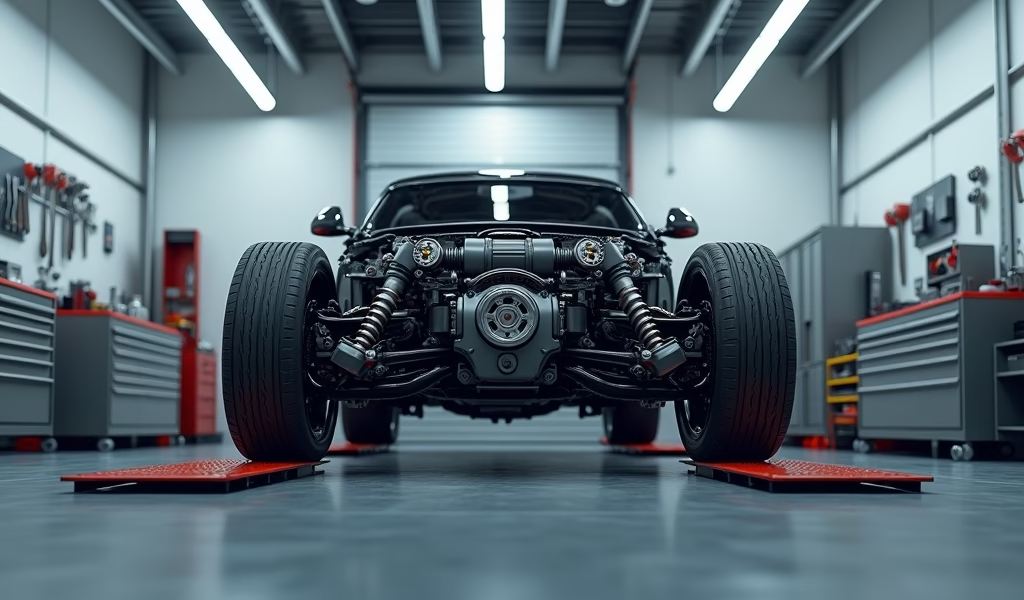Overview
This article explains steering box ratio—the mathematical relationship between steering wheel rotation and front wheel movement—including how to calculate it (by dividing 360 by degrees of front wheel rotation) and how different ratios suit various applications, from quick ratios (10:1-14:1) for performance driving to slower ratios (18:1-70:1) for off-roading and stability. Understanding and potentially modifying your vehicle’s steering ratio can transform handling characteristics and driving experience, though apparent ratio problems should first be investigated for worn components or alignment issues.
Table of Contents
- What Is Steering Box Ratio?
- Why Steering Box Ratio Matters
- How to Calculate Steering Box Ratio
- Pro Tips for Accurate Measurements
- Modifying Your Steering Ratio
- Optimal Ratios for Different Applications
- Troubleshooting Steering Issues
- Conclusion
- Frequently Asked Questions
Your steering wheel is like the conductor’s baton of your vehicle’s symphony – it translates your intentions into motion. At the heart of this translation lies the steering box ratio, an often overlooked but critical component that determines how your vehicle responds to your commands. Whether you’re navigating hairpin turns on a mountain road or simply maneuvering into a tight parking space, understanding your steering box ratio calculation can transform your driving experience from frustrating to fantastic.
In my 20+ years as a master mechanic, I’ve seen countless drivers struggle with steering issues that could have been solved with a proper understanding of this critical specification. Let’s dive into this fascinating aspect of vehicle handling together, and I promise to make it as painless as checking your oil!
What Is Steering Box Ratio?
Imagine trying to turn a massive ship with a tiny wheel – you’d need to spin that wheel many times to get even a small change in direction. Your car works on a similar principle, just on a smaller scale.
The steering box ratio is essentially a mathematical relationship that defines how much your front wheels turn in response to your steering wheel movement. Put simply, if your vehicle has a 16:1 steering ratio, you need to rotate your steering wheel 16 degrees to make your front wheels turn just 1 degree.
Think of it as a conversation between your hands and the road. A higher ratio (like 20:1) means you’re speaking formally and deliberately – lots of steering wheel input for modest wheel response. A lower ratio (like 12:1) is like speaking in slang – small movements translate to big directional changes.
This ratio determines several critical aspects of your driving experience:
- How many complete turns it takes to go from lock-to-lock
- The effort required to steer, especially at parking lot speeds
- How responsive your vehicle feels during lane changes
- The stability of your vehicle at highway speeds
Why Steering Box Ratio Matters
The difference between a properly matched steering ratio and an improper one is like wearing shoes that are the wrong size – you can still walk, but you’ll never feel quite right. And just like shoes, the “right” steering ratio depends entirely on what you’re doing.
For daily driving, a balanced ratio provides predictable control without requiring excessive effort. Most passenger vehicles come with ratios between 15:1 and 18:1, striking a balance between responsive handling and highway stability.
Performance enthusiasts crave quicker ratios (typically 12:1 to 14:1) that allow for lightning-fast direction changes with minimal hand movement. This is why sports cars feel so “twitchy” compared to your uncle’s Buick.
On the flip side, trucks, off-road rigs, and vehicles designed for stability often utilize slower ratios around 20:1 or higher. This provides more precise control when navigating difficult terrain and reduces the likelihood of sudden, unexpected direction changes at highway speeds.
Your steering ratio directly impacts:
- Driver fatigue on long journeys
- Confidence in emergency maneuvers
- Parking lot acrobatics
- The “personality” of your vehicle
As the foundation of the scrub radius calculation and other suspension geometry considerations, your steering ratio is part of a complex dance that determines how your vehicle handles.

How to Calculate Steering Box Ratio
Calculating your vehicle’s steering box ratio isn’t rocket science, but it does require the patience of a fishing enthusiast and the precision of a watchmaker. Let me walk you through the garage-tested method I’ve refined over decades of wrenching.
What You’ll Need:
- Tape measure or yardstick
- Chalk, masking tape, or dry-erase marker
- Level ground surface
- A friend (optional, but makes life easier)
- A cold beverage (essential for any garage project)
The Step-by-Step Process:
Step 1: Park your vehicle on a perfectly level surface with the front wheels pointing straight ahead. Set your parking brake and chock the rear wheels for safety.
Step 2: Make a clear reference mark on your steering wheel at the 12 o’clock position, and a corresponding mark on your dashboard or steering column. This is your starting point.
Step 3: Mark your front tires where they meet the pavement, or use the valve stems as natural reference points. If using valve stems, ensure they’re at the same position on both tires.
Step 4: Carefully turn the steering wheel exactly 360 degrees (one complete rotation) while counting how many degrees the front wheels turn. For greater precision, you can use a protractor against the wheel or measure the movement of the tire mark against a ruler on the ground.
Step 5: Calculate the ratio using this simple formula:
Steering Box Ratio = 360 ÷ (degrees of front wheel rotation)
For example, if your front wheels turned 24 degrees after one full steering wheel rotation:
Steering Box Ratio = 360 ÷ 24 = 15:1
This means your steering box has a 15:1 ratio – for every 15 degrees you turn the steering wheel, your front wheels turn 1 degree.
For greater accuracy, I recommend performing this test three times and taking the average. This helps account for any minor measurement errors or play in the system.
According to research from the Society of Automotive Engineers, variations of up to 5% between measurements are normal due to system flexing and tire compliance.
Pro Tips for Accurate Measurements
After teaching this procedure to hundreds of apprentice mechanics, I’ve learned that accurate steering ratio calculation is as much art as science. Here are my hard-won tips to ensure you get it right the first time:
- Check tire pressure before starting. Underinflated tires introduce flex that can throw off your measurements by as much as 10%. Set all tires to the manufacturer’s recommended pressure.
- Eliminate steering play first. Gently turn the wheel until you feel resistance, then back it off slightly. This removes the “dead zone” that can contaminate your readings.
- Use digital tools when possible. A digital angle finder ($20 at any hardware store) provides much more accurate measurements than eyeballing it.
- Test both directions. Measure turning both left and right, as wear in steering components can create directional variations. Average the results for the most accurate figure.
- Keep the vehicle weight consistent. Having someone sit in the driver’s seat during measurements better replicates real-world conditions by maintaining proper weight distribution.
The most common error I see in DIY calculations comes from failing to account for steering system play – that initial free movement before the wheels actually begin to turn. This can make your ratio appear slower (higher numerical value) than it actually is.
A properly maintained steering rack and pinion system should have minimal play, but even brand-new vehicles have some degree of designed-in free movement.

Modifying Your Steering Ratio
If your steering feels too sluggish for spirited driving or too twitchy for comfortable cruising, you’re not stuck with what the factory gave you. Think of your steering system like a recipe – sometimes a few substitutions can transform the whole dish!
Here are your main options for tweaking your ratio, from simplest to most complex:
1. Steering Box Replacement
For vehicles with traditional steering boxes, aftermarket units with quicker or slower ratios are widely available. This is the most direct approach and typically costs between $300-800 plus installation. Many performance-oriented replacements offer ratios around 12:1 to 14:1 compared to the stock 16:1 or 17:1.
2. Steering Arms and Linkage Modifications
By changing the length of your steering arms or the mounting points of your steering linkage, you can effectively alter the ratio without replacing major components. This approach is popular in the off-road community, where specialized “high-steer” kits can drastically change steering characteristics for better rock-crawling capability.
3. Rack and Pinion Conversion
For older vehicles with recirculating ball steering boxes, converting to a modern rack and pinion system can dramatically improve steering feel. This is a major undertaking (typically $1,500-3,000), but provides benefits beyond just ratio changes, including weight reduction and improved precision.
4. Quick-Ratio Steering Racks
For vehicles already equipped with rack and pinion steering, quick-ratio replacement racks can provide a sportier feel. Companies like Detroit Speed, Borgeson, and Flaming River offer direct replacements for many popular vehicles.
One creative approach I’ve seen gain popularity is the installation of caster/trail measurement adjustments alongside steering ratio changes, creating a complete handling package.
When modifying your steering ratio, remember that your vehicle’s suspension geometry, tire size, and power steering system were all designed around the factory ratio. Too aggressive of a change can lead to darty highway manners, increased steering effort, or even reduced steering assist function. NHTSA safety standards provide guidelines on steering modifications that maintain safe handling characteristics.
Optimal Ratios for Different Applications
Just as you wouldn’t wear hiking boots to a wedding or dress shoes on a mountain trail, different driving scenarios call for different steering ratios. Here’s my field guide to finding your perfect match:
Performance Driving
- Road Racing: 12:1 to 14:1 – Quick enough for responsive corner entry without becoming twitchy on straightaways
- Autocross: 10:1 to 12:1 – Lightning-fast response for navigating tight cone courses
- Drift Cars: 12:1 to 14:1 – Quick transitions with controllable counter-steering
- Drag Racing: 16:1 to 20:1 – Slower ratio for straight-line stability with minimal corrections
Off-Road Applications
- Rock Crawling: 35:1 to 70:1 – Extremely slow ratio for precise wheel placement
- Trail Riding: 20:1 to 35:1 – Balances control with reduced driver effort
- Overlanding: 18:1 to 22:1 – Comfortable for long drives while still capable on rough terrain
- Desert Racing: 16:1 to 20:1 – Stable at speed with enough quickness for obstacle avoidance
Daily Driving
- Commuter Cars: 15:1 to 17:1 – The sweet spot for balancing response and stability
- Luxury Vehicles: 16:1 to 18:1 – Prioritizes smooth, predictable handling
- Family SUVs: 17:1 to 19:1 – Forgiving handling with minimal twitchiness
- Classic Cars: 18:1 to 24:1 – Traditional ratios that match vintage driving dynamics
In my experience working with professional racing teams, the perfect ratio is ultimately subjective – it’s the one that gives you confidence behind the wheel and makes driving your vehicle a pleasure rather than a chore.
Troubleshooting Steering Issues
Sometimes, what seems like a ratio problem is actually something else entirely. Before you go swapping steering boxes, let’s diagnose what might really be happening when your steering doesn’t feel quite right:
Common Symptoms and Their Likely Causes
Inconsistent steering feel: If your steering feels different depending on direction or speed, you likely have worn steering components rather than an inappropriate ratio. Check tie rod ends, ball joints, and steering couplings for excessive play.
Excessive play (more than 1-2 inches of wheel movement without response): This usually indicates wear in your steering linkage or gearbox. A worn pitman arm, loose steering coupling, or deteriorated rack bushings are common culprits.
Steering feels too heavy: Before blaming your ratio, check power steering fluid level and condition, belt tension, and power steering pressure. Low fluid or a weak pump often masquerades as a ratio problem.
Darty or nervous highway steering: This could be a genuinely too-quick ratio, but also check your wheel alignment, particularly caster angle. Insufficient positive caster creates unstable straight-line tracking that feels similar to an overly quick ratio.
Here’s my tried-and-true diagnostic approach:
- Perform a thorough inspection of all steering and suspension components with the vehicle safely raised on jack stands
- Check for unusual tire wear patterns that might indicate alignment issues
- Verify power steering system operation (if equipped)
- Measure actual steering ratio using the method described earlier
- Compare your findings with factory specifications
Remember, even the perfect steering ratio can’t compensate for worn components or improper alignment. Fix the fundamentals first, then fine-tune your ratio if still needed.
Conclusion
Your vehicle’s steering box ratio is like the secret ingredient in your favorite recipe – invisible to most, but fundamental to the overall experience. Whether you’re seeking the precision of a surgeon’s scalpel or the forgiveness of a comfortable cruiser, understanding and potentially optimizing your steering ratio can transform your relationship with your vehicle.
Through proper calculation, thoughtful modification if necessary, and regular maintenance of your steering system, you can ensure your vehicle responds exactly how you want it to – whether you’re parallel parking downtown or carving canyon roads on the weekend.
Remember that the “perfect” ratio doesn’t exist in absolute terms – it’s whatever matches your specific vehicle, driving style, and intended use. A ratio that feels divine on a track day might feel exhausting during your daily commute. The beauty of understanding this aspect of your vehicle is that you can make informed decisions about potential modifications rather than relying on generic recommendations.
So grab your measuring tools, head out to the garage, and discover the mathematical relationship that’s been influencing your driving experience all along. Your hands (and your passengers) will thank you for the smoother, more intuitive connection to the road that comes from a properly matched steering box ratio.
Frequently Asked Questions
What’s the difference between a quick and slow steering ratio?
A quick ratio (lower number like 12:1) requires less steering wheel rotation to turn the wheels, making the steering feel more responsive but potentially twitchy. A slow ratio (higher number like 20:1) requires more steering wheel movement, providing more precise control but requiring more effort.
Will changing my steering ratio affect my alignment?
Typically no, steering ratio modifications don’t directly impact alignment settings like toe, camber, or caster. However, if you’re replacing major steering components, a post-installation alignment is always recommended.
Can I change my steering ratio without replacing the entire steering box?
For some vehicles, changing just the steering arms or pitman arm can effectively modify your ratio without a complete box replacement. This approach is more common in older vehicles and off-road applications.
How do I know if my steering ratio is too quick or too slow?
If you find yourself constantly making small corrections at highway speeds, your ratio might be too quick. If parking requires excessive steering wheel rotation and arm movement, your ratio could be too slow.
Does power steering affect the steering ratio?
Power steering doesn’t change the mechanical ratio itself, but it can make a slower ratio feel more manageable by reducing the effort required. Variable-assist power steering can create the sensation of a variable ratio even when the mechanical ratio remains constant.

